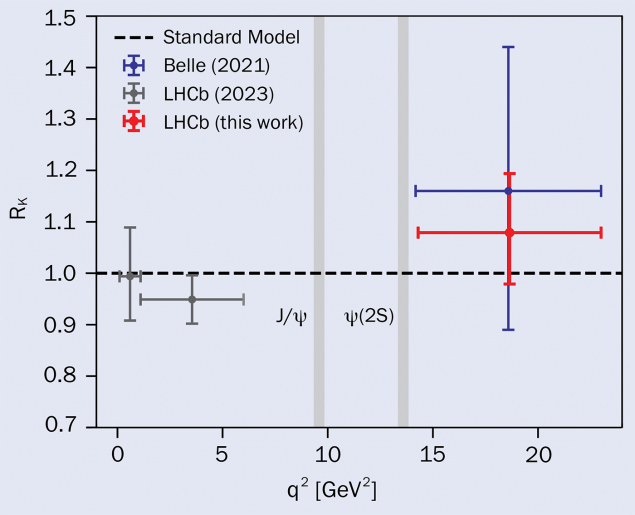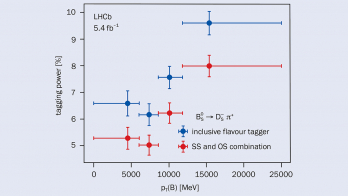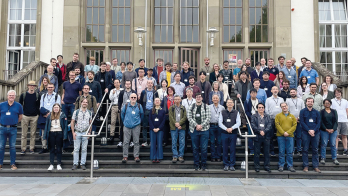A report from the LHCb experiment.

A new result from the LHCb collaboration supports the hypothesis that the rare decays B± → K±e+e– and B± → K±µ+µ– occur at the same rate, further tightening constraints on the magnitude of lepton flavour universality (LFU) violation in rare B decays. The new measurement is the most precise to date in the high-q2 region and the first of its kind at a hadron collider.
LFU is an accidental symmetry of the Standard Model (SM). Under LFU, each generation of lepton ℓ± (electron, muon and tau lepton) is equally likely to interact with the W boson in decay processes such as B± → K±ℓ+ℓ–. This symmetry leads to the prediction that the ratio of branching fractions for these decay channels should be unity except for kinematic effects due to the different masses of the charged leptons. The most straightforward ratio to measure is that between the muon and electron decay modes, known as RK. Any significant deviation from RK = 1 could only be explained by the existence of new physics (NP) particles that preferentially couple to one lepton generation over another, violating LFU.
B± → K±ℓ+ℓ– decays are a powerful probe for virtual NP particles. These decays involve an underlying b–to–s quark transition – an example of a flavour-changing neutral current (FCNC). FCNC transitions are extremely rare in the SM, as they occur only through higher-order Feynman diagrams. This makes them particularly sensitive to contributions from NP particles, which could significantly alter the characteristics of the decays. In this case, the mass of the NP particles could be much larger than can be produced directly at the LHC. “Indirect” searches for NP, such as measuring the precisely predicted ratio RK, can probe mass scales beyond the reach of direct-production searches with current experimental resources.
The new measurement is the most precise to date in the high-q2 region
In the decay process B± → K±ℓ+ℓ–, the final-state leptons can also originate from an intermediate resonant state, such as a J/ψ or ψ(2S). These resonant channels occur through tree-level Feynman diagrams. Their contributions significantly outnumber the non-resonant FCNC processes and are not expected to be affected by NP. RK is therefore measured in ranges of dilepton invariant mass-squared (q2), which exclude these resonances, to preserve sensitivity to potential NP effects in FCNC processes.
The new result from the LHCb collaboration measures RK in the high-q2 region, above the ψ(2S) resonance. The high-q2 region data has a different composition of backgrounds compared to the low-q2 data, leading to different strategies for their rejection and modelling, and different systematic effects. With RK expected to be unity in all domains in the SM, low-q2 and high-q2 measurements offer powerfully complementary constraints on the magnitude of LFU-violating NP in rare B decays.
The new measurement of RK agrees with the SM prediction of unity and is the most precise to date in the high-q2 region (figure 1). It complements a refined analysis below the J/ψ resonance published by LHCb in 2023, which also reported RK consistent with unity. Both results use the complete proton–proton collision data collected by LHCb from 2011 to 2018. They lay the groundwork for even more precise measurements with data from Run 3 and beyond.
Further reading
LHCb Collab. 2025 LHCb-PAPER-2024-056.







